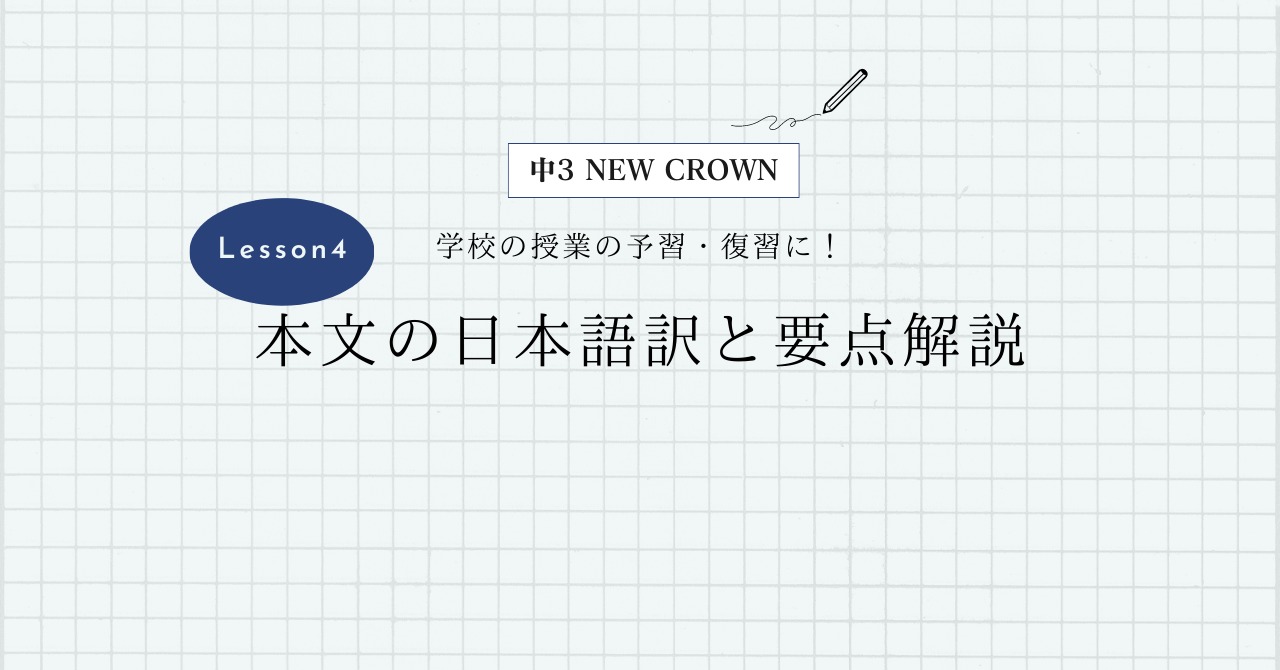三省堂 中学3年生 NEW CROWN(ニュークラウン) Lesson4 Part3の本文の日本語訳と重要箇所の解説です。
Lesson4-1,4-2の解説はこちらからご覧ください。
>中3NEW CROWN Lesson4 Part1 本文和訳
>中3NEW CROWN Lesson4 Part2 本文和訳
- Lesson4 Part3 本文と日本語訳
- Lesson4 Part3 重要事項の解説
- People around the world now know and love Japanese anime.
- Some characters are familiar to people who do not usually read manga or watch anime.
- One of the reasons for this success is the adjustments that were made for viewers overseas.
- Three of them involve titles, characters, and content.
- Manga and anime titles are, of course, originally in Japanese.
- Some, like JoJo’s Bizarre Adventure, are translated literally into English.
- However, this does not work with all titles.
- It describes just the main character, but in English, the title was changed to something that relates to the whole story.
- This made it more attractive to viewers in foreign countries.
- Characters’ names are often changed in manga and anime that are mainly for children.
- It is hard for children to remember unfamiliar names.
- With familiar names, children can focus on the story.
- The name Ash uses three letters from S-a-t-o-s-h-i.
- Japanese customs are sometimes adjusted for non-Japanese viewers.
- The adjustments can be small or large.
- Consider this example of a small adjustment.
- In Western versions, they eat cookies.
- Instead they add short explanations.
- This way, foreign readers can understand Japanese customs and behavior.
- A large adjustment might be a change in the setting.
- Consider Kyojin no Hoshi, an anime from the 1970s.
- In it, the main character Hyuma trains very hard and becomes a professional baseball player.
- In the Indian version, its main character plays cricket, a popular team sport in India.
- In short, perhaps anime became more popular because of these adjustments.
- The language and customs were adapted a little to fit each culture.
- The original is probably different.
- Lesson4 Part3 まとめ
Lesson4 Part3 本文と日本語訳
Manga, Anime, and the World
「漫画,アニメ,そして世界」
People around the world now know and love Japanese anime.
「世界中の人は今や日本のアニメを知っているし,愛しています。」
Some characters are familiar to people who do not usually read manga or watch anime.
「一部のキャラクターは,普段漫画を読んだりアニメを見ない人にもよく知られています。」
One of the reasons for this success is the adjustments that were made for viewers overseas.
「この成功の理由の1つは,海外の視聴者のためになされた調整です。」
Three of them involve titles, characters, and content.
「調整とはタイトル,キャラクター,内容の3つです。」
Titles 「タイトル」
Manga and anime titles are, of course, originally in Japanese.
「漫画とアニメのタイトルはもちろん元々は日本語です。」
Some, like JoJo’s Bizarre Adventure, are translated literally into English.
「『ジョジョの奇妙な冒険』のように,文字通り英語に翻訳されているものもあります。」
However, this does not work with all titles.
「しかし,これはすべてのタイトルで行われてはいません。」
For example, Knights of the Zodiac is originally Seinto Seiya in Japanese.
「例えば,『黄道十二宮の騎士』は元々日本語で『聖闘士星矢』です。」
It describes just the main character, but in English, the title was changed to something that relates to the whole story.
「それはただメインキャラクターを表していますが,英語では,タイトルが物語全体に関係するものに変えられました。」
This made it more attractive to viewers in foreign countries.
「これによって,外国の視聴者をより惹きつけるものになりました。」
Characters 「キャラクター」
Characters’ names are often changed in manga and anime that are mainly for children.
「主に子どものための漫画やアニメでは,キャラクターの名前がよく変えられます。」
It is hard for children to remember unfamiliar names.
「子どもたちにとってよく知らない名前は覚えるのが大変です。」
With familiar names, children can focus on the story.
「よく知られている名前を使うことで,子どもたちは物語に集中することができます。」
For example, the character Satoshi in Pokémon becomes Ash in English.
「例えば,ポケモンのキャラクターのサトシは英語では”Ash”になっています。」
The name Ash uses three letters from S-a-t-o-s-h-i.
「”Ash”という名前は”Satoshi”の中の3つの文字を使っています。」
Content 「内容」
Japanese customs are sometimes adjusted for non-Japanese viewers.
「日本の習慣が,日本人ではない視聴者のために時々少し変えられます。」
The adjustments can be small or large.
「その変更は小さいことも大きいこともあります。」
Consider this example of a small adjustment.
「小さな変更の例を考えてみましょう。」
In anime in Japan, characters eat onigiri.
「日本のアニメでは,キャラクターはおにぎりを食べます。」
In Western versions, they eat cookies.
「西洋版では,クッキーを食べます。」
In manga, they don’t change the pictures.
「漫画では,絵は変えません。」
Instead they add short explanations.
「代わりに,短い説明を追加します。」
This way, foreign readers can understand Japanese customs and behavior.
「このようにして,外国の読者は日本人の習慣や行動を理解することができます。」
A large adjustment might be a change in the setting.
「大きな変更としては,設定が変わることがあります。」
Consider Kyojin no Hoshi, an anime from the 1970s.
「1970年代のアニメ『巨人の星』を考えてみましょう。」
In it, the main character Hyuma trains very hard and becomes a professional baseball player.
「『巨人の星』では,メインキャラクターの飛雄馬がとても一生懸命練習して,プロの野球選手になります。」
In the Indian version, its main character plays cricket, a popular team sport in India.
「インド版では,そのメインキャラクターはインドで人気のチームスポーツであるクリケットをプレーしています。」
In short, perhaps anime became more popular because of these adjustments.
「要するに,おそらくこういった変更のおかげでアニメはより人気になりました。」
The language and customs were adapted a little to fit each culture.
「言語と習慣は,各文化に合うように少し変化してきました。」
Think about your favorite manga or anime.
「あなたのお気に入りの漫画やアニメについて考えてみましょう。」
The original is probably different.
「元々のものは多分違う点がありますよ。」

Lesson4 Part3 重要事項の解説
People around the world now know and love Japanese anime.
“around the world“は「世界中」という表現です。
同じ意味で“all over the world”もあるので,あわせて覚えておきましょう。
Some characters are familiar to people who do not usually read manga or watch anime.
“familiar”は「よく知られた,親しみのある」という形容詞です。
“who”は「主格の関係代名詞」で,“people”を修飾していますね。
One of the reasons for this success is the adjustments that were made for viewers overseas.
この文は「there構文」が使われていますね。
“performance”は「演技,上演,業績」といった意味がありますが,そのまま「パフォーマンス」でもOKです。
“by”は前置詞で「~によって,~による」となります。
他にもいろいろな意味があるので簡単にまとめておきます。
Three of them involve titles, characters, and content.
“talk”は名詞で「話」という意味ですね。
ここの“by”も「~による」という意味で使われています。
“manga artist”は「漫画家」,“director”は「監督,指導者」という意味です。
Manga and anime titles are, of course, originally in Japanese.
“of course”は「もちろん」という意味で,今回は“are”の後ろに挿入されていますが,訳すときは好きな位置に持ってきてOKです。
“originally”は「元々は,最初は」という副詞になります。
Some, like JoJo’s Bizarre Adventure, are translated literally into English.
主語の“some”は「~のもある」くらいで訳してあげましょう。“like”は前置詞で「~のような」という意味ですね。
“translate A into B”で「AをBに翻訳する,変える」という意味で,今回は「受動態」になっていますね。
“literally”は「文字通り」という副詞になります。
However, this does not work with all titles.
“however”は「しかし」という意味の副詞になります。
同じ意味で“but”がありますが,こちらは接続詞なので品詞が異なります。“but”は“文A,but 文B”というように,2つの文を繋ぐ際に使います。
“文A. But 文B.”というように,“but”を文の先頭に置いて1文だけで完結させるのは原則NGとなります。
“work”はこの文では「行われる」と訳しました。
It describes just the main character, but in English, the title was changed to something that relates to the whole story.
“describe”は「を述べる,言い表す」という動詞で,“just”は「ただ~だけ」という副詞ですね。
“was changed”は「受動態」になっていて,“that”は「主格の関係代名詞」で“something”を修飾しています。
“relate to~”は「~と関係がある」,“whole”は「全体の」という形容詞です。
This made it more attractive to viewers in foreign countries.
“make 人・もの 名詞/形容詞”で「人・ものを~にさせる」という重要表現です。
“attractive”は「魅力的な,惹きつける」という形容詞で,“viewer”は「視聴者」です。
“foreign”は「外国の」という形容詞になります。
また,“more”が付いているので「比較級」も使われていますね。
この文のように主語が「人以外」のときは,「~によって」くらいで訳してあげると綺麗な日本語になりやすいです。
Characters’ names are often changed in manga and anime that are mainly for children.
“are often changed”は「受動態」になっていて,“that”は「主格の関係代名詞」で“manga and anime”を修飾しています。
詞に‘sを付けると「~の」という所有を表します。直前の名詞が複数形のときは” Characters‘ “のようにアポストロフィーだけを最後に付けます。
“mainly”は「主に」という副詞です。
It is hard for children to remember unfamiliar names.
ここでは「it to構文」が使われていますね。
“remember”は「を覚えている,思い出す」という動詞で,“unfamiliar”は「よく知らない,慣れていない」という形容詞になります。
With familiar names, children can focus on the story.
“with”は前置詞で「~と一緒に」と訳すことが多いですが,必ずしも後ろに人が来るわけではありません。イメージとして「~とセットで」と覚えておきましょう。
訳し方としては「~を使って」「~で」など文脈に合わせて柔軟に変えてあげましょう。
“focus”は「に焦点を合わせる」という動詞で,“focus on”で「に集中する,重きを置く」という意味になります。
The name Ash uses three letters from S-a-t-o-s-h-i.
“The name”と“Ash”は「同格語」なのでイコールで結べますね。
“letter”は「手紙」のほかに「文字」という意味もありますよ。
Japanese customs are sometimes adjusted for non-Japanese viewers.
“custom”は「習慣」という名詞です。
“are sometimes adjusted”は「受動態」になっていますね。
“adjust”は「を調整する,変更する」という動詞です。
The adjustments can be small or large.
“adjustment”は「調整,変更」という名詞です。
“can”は「~のことがある」という可能性の意味で使うこともあります。
Consider this example of a small adjustment.
この文は「命令文」になっていて,“consider”は「を考慮する」という動詞になります。
“example”は「例」という名詞です。
In Western versions, they eat cookies.
“Western”は「西洋の」という形容詞で,“version”は「型,版,意見」といった名詞です。
Instead they add short explanations.
“instead”は「代わりに」という副詞です。
“add”は「を追加する」という動詞で,“explanation”は名詞で「説明」となります。
This way, foreign readers can understand Japanese customs and behavior.
“this way”は「このように」という表現です。
“behavior”は「行動,振る舞い」という名詞になります。
A large adjustment might be a change in the setting.
助動詞“might”は“may”の過去形で,「~かもしれない,~のことがある」という推量や可能性を表します。
ただ,この文のように”might”は現在形で使うこともでき,その場合は”may”よりも程度が低いというニュアンスになります。
“setting”は「設定」という名詞です。この文を直訳すると「大きな変更は設定の変化になることもある」といった感じです。
Consider Kyojin no Hoshi, an anime from the 1970s.
西暦に”s”を付けると「~年代」という意味になります。
また,千と百の位をアポストロフィにして書く表現もあります。例えば「1990年代」なら” ’90s “となります。
In it, the main character Hyuma trains very hard and becomes a professional baseball player.
“train”は「訓練する,練習する」という動詞です。
“professional”は「プロの,専門の」という形容詞になります。
In the Indian version, its main character plays cricket, a popular team sport in India.
“a popular team sport in India”は直前の“cricket”と「同格」の関係になっていますね。
“名詞,名詞”の並びは「同格」の可能性が高いです。
In short, perhaps anime became more popular because of these adjustments.
“in short”は「要するに,手短に言うと」という重要表現です。
“perhaps”は「多分,おそらく」という副詞で,“because of~”は「~のおかげで」という重要表現になります。
また,“more”が付いているので「比較級」も使われていますね。
The language and customs were adapted a little to fit each culture.
“were adapted“は「受動態」になっていますね。
“adapt”は「を変化させる」という動詞なので,受動態にすると「変化する」という意味になります。
“a little”は「少し」という重要表現ですね。
“to fit”は「不定詞の副詞的用法」で,“fit”は「~に合う」という動詞です。
“each”は「それぞれの」という形容詞で,“culture”は「文化」という名詞になります。
The original is probably different.
“oroginal”は「原型,オリジナル」という名詞で,“probably”は「多分,おそらく」という副詞です。
“different”は「異なった,違った」という形容詞になります。
Lesson4 Part3 まとめ
以上がLesson4 Part3の日本語訳となります。
ここでは「主格の関係代名詞」が使われていますね。用法と訳し方をしっかり理解していきましょう!
>中3NEW CROWN Lesson4 Part1 本文和訳
>中3NEW CROWN Lesson4 Part2 本文和訳
何か分からない点や他に解説してほしい点があれば,お気軽にコメントしてください!




コメント